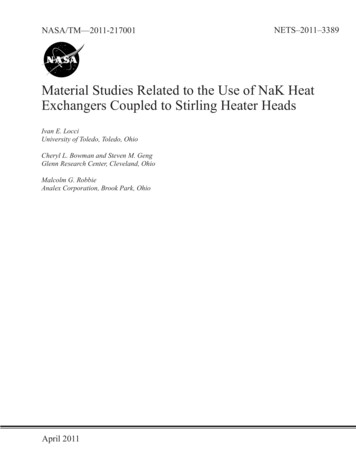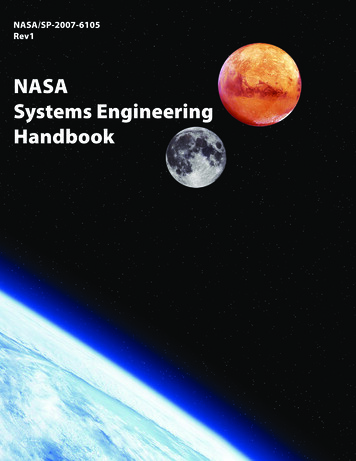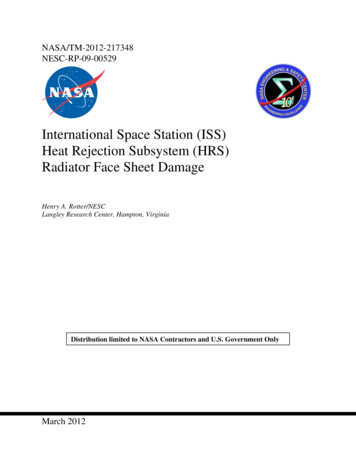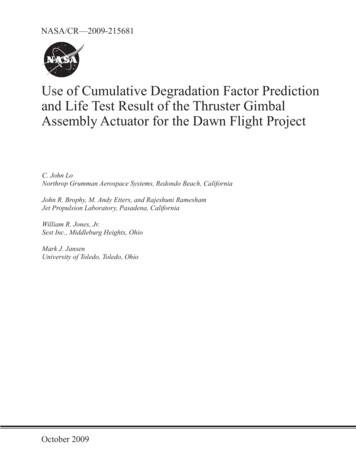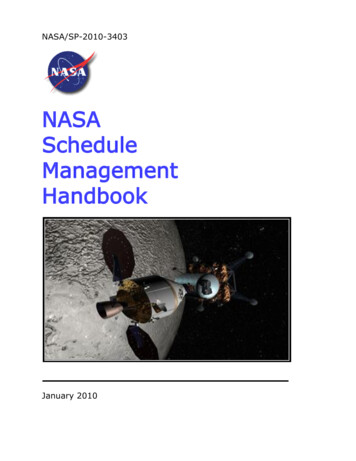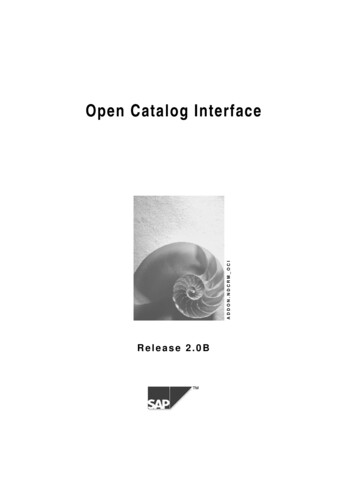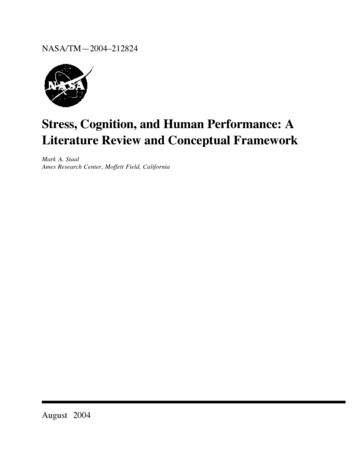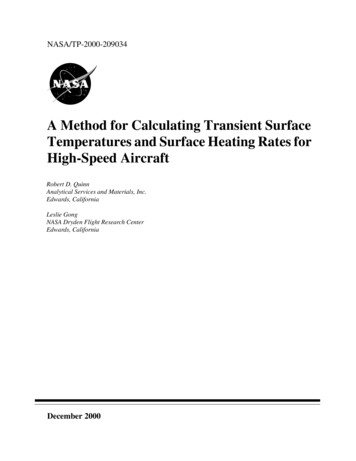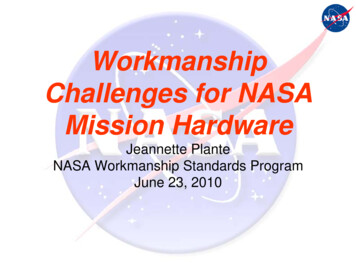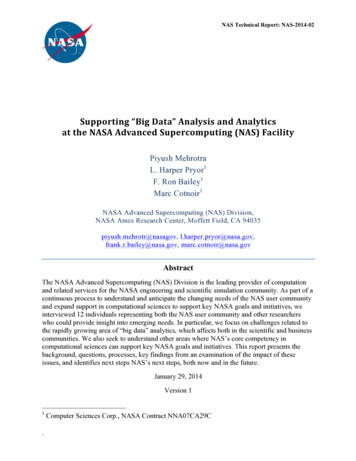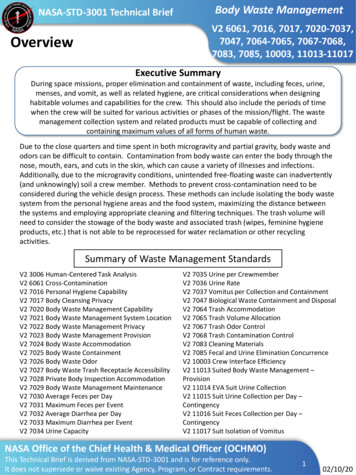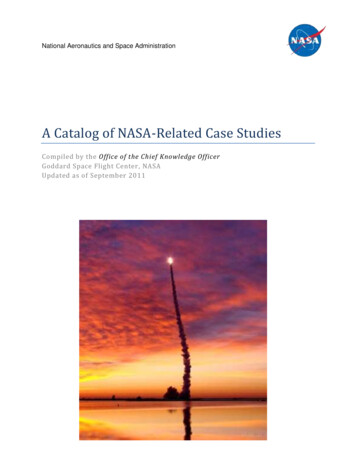
Transcription
National Aeronautics and Space AdministrationA Catalog of NASA-Related Case StudiesCompiled by the Office of the Chief Knowledge OfficerGoddard Space Flight Center, NASAUpdated as of September 2011
ContactDr. Edward W. RogersChief Knowledge OfficerOffice of the Chief Knowledge OfficerGoddard Space Flight CenterNASAVersion 1.8Publication Date: September 2011Disclaimer: This document links to many Web sites created and maintained by public and/or privateorganizations other than NASA. NASA provides links to these sites as a service to our readers. Thepresence of a link is not a NASA endorsement of the site.When users follow a link to an outside Web site, they are leaving NASA and are subject to the privacyand security policies of the owners/sponsors of the outside Web site(s). NASA is not responsible for theinformation collection practices of non-NASA sites.Cover Image: The TacSat-2 launches from Wallops Flight Facility. Credit: NASA
ALPHABETICAL INDEXCase TitleLengthSubject FocusPageABCs of OCI: Know You Don’t4AGATE: The Turning Point forGeneral Aviation35Atlas Centaur-67: Go or No Go forLaunch?3Building the Team: The Ares I-XUpper Stage Simulator10Collaborative Problem-Solving: TheSTS-119 Flow Control Valve Issue13Columbia's Final Mission33Shuttle accident; Decision making;Communication; Crisis management;6Columbia’s Final Mission (MultimediaCase)n/aBeliefs; Crisis communication; Crisis prevention;Group behavior; Group dynamics; Managerialskills7Hubble; Communication; Risk management8Contract management; Decision makingProject management; Revitalizing industryLaunch decisionExpertise; Facilities renovation; Large scalefabrication; Staffing; RetrainingProblem-solving; Collaboration12345Communication Aberration4Cover Blown - The WIRE SpacecraftMishap4Earth Observing System DataInformation System (EOSDIS)35Fender Bender - DART's AutomatedCollision4Final Voyage of the Challenger35Shuttle accident; Decision making; Riskmanagement12Fire in the Cockpit - The Apollo 1Tragedy4Design and material issues; Quality control;Emergency preparedness; Budget and schedulepressures; Complacency13Goddard Space Flight Center:Building A Learning Organization20 12On-orbit failure; Test-as-you-fly; Peer reviewsR&D environment vs. operational environment;Developers vs. users; Instability of requirements;Acquisition strategyNavigational system error; On-orbit failureOrganizational learning9101114GOES-N: Long and Winding Road toLaunch8Managing fixed-price contract; Technical role inlaunch decision; Managing exigencies15Gravity Probe B11Schedule pressures; Launch decisions; Riskmanagement; Risk mitigation16Hit the Bricks4Launch facilities; Safety; KSC; Space Shuttle17HMS Thetis and Apollo XIII21Disaster management18Hubble Space Telescope: SystemsEngineering Case Study69IBEX: Managing Logistical Exigencies1Systems engineeringLogistics; CommunicationOffice of the Chief Knowledge Officer, Goddard Space Flight Center, NASA1920i
Case TitleLengthSubject FocusPageIMAGEn/aBudget; Schedule; Science; Team; Projectmanagement21International Project Management:The Cassini-Huygens Mission14On-orbit failure; Telemetry; Internationalcollaboration; ITAR22International Space Station: SystemsEngineering Case Study105Launching New Horizons: The RP-1Tank Decision16Governance model; Independent technicalauthority; Transparent decision making24Launching the Vasa6Risk management; Communication,Organizational culture; Technologies,Requirements, Schedules, Budgeting; Accidents25Lessons from the Challenger LaunchDecision13Launch decision; Safety, Organizational culture;Risk management; decision making; engineeringdesign26Lewis Spins out of Control4―Faster, better, cheaper‖ (FBC); On-orbit failure27Lifting NOAA-N Prime4Risk management; Communication;Organizational culture; Contract management28Lost in Translation - The Mars ClimateOrbiter Mishap4Lost in Space: A Case Study inEngineering Problem Solving8Engineering problem solving; ―Faster, better,cheaper‖ (FBC)30Lunar Crater Observation andSensing Satellite (LCROSS)8Risk management; Communication, Projectmanagement31Managing Knowledge and Learning atNASA and the Jet PropulsionLaboratory (JPL)30Mechanical Systems EngineeringSupport Contract Re-Compete4Organizational culture; Communication; Contractmanagement33Mission to Mars4Failure; Investigation; Contract management; Riskmanagement34M.S.T.I.: Optimizing the WholeSystem27NASA After Challenger: Restoring anImage18NEAR (Near Earth AsteroidRendezvous)n/aNOAA-N Prime Case Study38Safety; Risk management; Accidents38Pegasus XL-HESSI: Last-MinuteDecisions in Flight-Based Launch8Decision making; Communication; RiskManagement39Redesigning the Cosmic BackgroundExplorer (COBE)10Launch vehicle; Redesign; Matrix management;Mass; Co-location; Test-as-you-fly40Systems engineering; PartnershipsSpacecraft trajectory; Ground software2329Knowledge management; Organizational learning32Systems engineering across a projectDisaster management; Media relations;Management communicationRedesign; Managing changeOffice of the Chief Knowledge Officer, Goddard Space Flight Center, NASA353637ii
Case TitleLengthSubject FocusPageSearching for Life on Mars: TheDevelopment of the Viking GasChronomatograph MassSpectrometerInstrument development; Project management8Shuttle Software Anomaly4Software anomaly; "Test as you fly"; Anomalydocumentation42Sitting on the Fence: Launching aBalloon in the Outback10Launch vehicle; Decision making; Safety; Failure;Accidents43Skin in the Game: QuestioningOrganizational Conflict of Interest4Space Shuttle6Behavior; Human resources management;Organizational behavior; Organizational structure;Quantitative analysis45Space-to-Space communicationsSystem6Schedule pressures; Testing; Spacecommunications; In-house development46Spektr of Failure4Hubble; Communication; Risk management47ST5 - Miniaturized Space Technology4Communication48STEREO: Organizational Cultures inConflict5Organizational culture; Communication; Tests;Schedules; Budgeting49Stormy Weather: Lightning Strike onthe Launch Padn/aSuper Lightweight Tank: A RiskManagement Case Study in MassReduction44TDRSS: Fixed-Cost versus Cost-PlusContracting7TDRSS K, L: Working with a FixedPrice Contract6The CALIPSO Mission: ProjectManagement in the "PI Mode": Who'sin Charge?9The CEV Seat: Seeking a SemiCustom Fit in an Off-the-Rack World7Contract management; Requirements;Engineering; Schedule; Review; Learning55The Dart Mission: ChangingEnvironment, Shifting Priorities, HardDecisions6Communication; Contract management;Engineering; Instruments; ITAR; Launch vehicles;Politics; Project management; Roles;Technologies; Tests56The Million Mile Rescue - SOHO Lostin Space4In space recovery; Extending the mission; Groundoperations57The NFIRE Launch: Beating theSophomore Slump at the WallopsRange741Contract management; Decision makingShuttle launch; Decision-makingRisk management; Risk mitigation: RiskassessmentContract management; Organizational culture;Schedules; BudgetingContract management; RequirementsInteragency communication; Roles; Relationships;ITAR and international partnershipsChoosing your biggest worry; Launch decisionmakingOffice of the Chief Knowledge Officer, Goddard Space Flight Center, NASA44505152535458iii
Case TitleLengthThe Pursuit of Images of Columbia6The Tour Not Taken - NASA's CometNucleus Tour (CONTOUR)4Thermosphere IonosphereMesosphere Energetics andDynamics Project (TIMED) CaseStudySubject FocusCommunication; Organizational silence;Accidents; Hierarchical barriers; SafetyOn-orbit failure; Team integration; Faulty designPage596021Programmatic challenges; Mission requirements;Center buy-in; Managing expectations; Lines ofauthority; Rules of engagement; Complexrelationships; Personality conflicts61Vegetation Canopy Lidar12Weak project management; Institutional oversight;62Wait, Wait, Don’t Launch4Contract management; Risk management;Decision making63Wide-Field Infrared Explorer (WIRE)16"Faster, better, cheaper" mandate; Geographicallydispersed teams; Communications;64Office of the Chief Knowledge Officer, Goddard Space Flight Center, NASAiv
INDEX BY CASE LENGTHCase TitleLengthPageIMAGEn/a21NEAR (Near Earth Asteroid Rendezvous)n/a37Stormy Weather: Lightning Strike on the Launch Padn/a50Columbia’s Final Mission (Multimedia Case)n/a6IBEX: Managing Logistical Exigencies120Atlas Centaur-67: Go or No Go for Launch?33ABCs of OCI: Know You Don’t41Communication Aberration48Cover Blown - The WIRE Spacecraft Mishap49Fender Bender - DART's Automated Collision411Fire in the Cockpit - The Apollo 1 Tragedy413Hit the Bricks417Lewis Spins out of Control427Lifting NOAA-N Prime428Lost in Translation - The Mars Climate Orbiter Mishap429Mechanical Systems Engineering Support Contract Re-Compete433Mission to Mars434Shuttle Software Anomaly442Skin in the Game: Questioning Organizational Conflict of Interest444Spektr of Failure447ST5 - Miniaturized Space Technology448The Million Mile Rescue - SOHO Lost in Space457The Tour Not Taken - NASA's Comet Nucleus Tour (CONTOUR)460Wait, Wait, Don’t Launch463STEREO: Organizational Cultures in Conflict549The Pursuit of Images of Columbia659Space-to-Space communications System646The Dart Mission: Changing Environment, Shifting Priorities, Hard Decisions656Space Shuttle645Launching the Vasa625TDRSS K, L: Working with a Fixed Price Contract653The NFIRE Launch: Beating the Sophomore Slump at the Wallops Range758Office of the Chief Knowledge Officer, Goddard Space Flight Center, NASAv
Case TitleLengthPageTDRSS: Fixed-Cost versus Cost-Plus Contracting752The CEV Seat: Seeking a Semi-Custom Fit in an Off-the-Rack World755GOES-N: Long and Winding Road to Launch815Pegasus XL-HESSI: Last-Minute Decisions in Flight-Based Launch839Searching for Life on Mars: The Development of the Viking Gas ChronomatographMass Spectr.8Lost in Space: A Case Study in Engineering Problem-Solving830Lunar Crater Observation and Sensing Satellite (LCROSS)831The CALIPSO Mission: Project Management in the "PI Mode": Who's in Charge?954Building the Team: The Ares I-X Upper Stage Simulator104Sitting on the Fence: Launching a Balloon in the Outback1043Redesigning the Cosmic Background Explorer (COBE)1040Gravity Probe B1116Vegetation Canopy Lidar1262Collaborative Problem-Solving: The STS-119 Flow Control Valve Issue135Lessons from the Challenger Launch Decision1326International Project Management: The Cassini-Huygens Mission1422Launching New Horizons: The RP-1 Tank Decision1624Wide-Field Infrared Explorer (WIRE)1664NASA After Challenger: Restoring an Image1836Thermosphere Ionosphere Mesosphere Energetics and Dynamics Project (TIMED)Case Study21HMS Thetis and Apollo 13211820 1214M.S.T.I.: Optimizing the Whole system2735Managing Knowledge and Learning at NASA and the Jet Propulsion Laboratory(JPL)30Columbia's Final Mission336AGATE: The Turning Point for General Aviation352Earth Observing System Data Information System (EOSDIS)3510Final Voyage of the Challenger3512NOAA-N Prime Case Study3838Super Lightweight Tank: A Risk Management Case Study in Mass Reduction4451Hubble Space Telescope: Systems Engineering Case Study6919International Space Station: Engineering Case Study10523Goddard Space Flight Center: Building A Learning OrganizationOffice of the Chief Knowledge Officer, Goddard Space Flight Center, NASA416132vi
INDEX BY SOURCEOffice of the Chief Knowledge Officer (OCKO), NASA/GSFCCase TitleLengthPageABCs of OCI: Know You Don’t41Atlas Centaur-67: Go or No Go for Launch?33GOES-N: Long and Winding Road to Launch815IBEX: Managing Logistical Exigencies120Launching the Vasa825Lessons from the Challenger Launch Decision1326Lifting NOAA-N Prime428Mechanical Systems Engineering Support Contract Re-Compete433Pegasus XL-HESSI: Last-Minute Decisions in Flight-Based Launch839Sitting on the Fence: Launching a Balloon in the Outback1043Skin in the Game: Questioning Organizational Conflict of Interest444ST5 - Miniaturized Space Technology448STEREO: Organizational Cultures in Conflict549TDRSS: Fixed-Cost versus Cost-Plus Contracting752TDRSS K, L: Working with a Fixed Price Contract653The CALIPSO Mission: Project Management in the "PI Mode": Who's in Charge?954The CEV Seat: Seeking a Semi-Custom Fit in an Off-the-Rack World755The Dart Mission: Changing Environment, Shifting Priorities, Hard Decisions656The NFIRE Launch: Beating the Sophomore Slump at the Wallops Range758The Pursuit of Images of Columbia659Wait, Wait, Don’t Launch463Office of the Chief Knowledge Officer, Goddard Space Flight Center, NASAvii
NASA Safety Center (NSC)Case TitleLengthPageCommunication Aberration48Cover Blown - The WIRE Spacecraft Mishap49Fender Bender - DART's Automated Collision411Fire in the Cockpit - The Apollo 1 Tragedy413Hit the Bricks417Lewis Spins out of Control427Lost in Translation - The Mars Climate Orbiter Mishap429Mission to Mars434Shuttle Software Anomaly442Spektr of Failure447The Million Mile Rescue - SOHO Lost in Space457The Tour Not Taken - NASA's Comet Nucleus Tour (CONTOUR)460NOAA-N Prime Case Study3838Academy of Program/Project & Engineering Leadership (APPEL), NASACase TitleLengthPageBuilding the Team: The Ares I-X Upper Stage Simulator104Collaborative Problem-Solving: The STS-119 Flow Control Valve Issue135Earth Observing System Data Information System (EOSDIS)3510Gravity Probe B1116IMAGEn/a21International Project Management: The Cassini-Huygens Mission1422Launching New Horizons: The RP-1 Tank Decision1624Lunar Crater Observation and Sensing Satellite (LCROSS)832NEAR (Near Earth Asteroid Rendezvous)n/a37Redesigning the Cosmic Background Explorer (COBE)1040Searching for Life on Mars: The Development of the Viking Gas ChronomatographMass Spectrometer841Office of the Chief Knowledge Officer, Goddard Space Flight Center, NASAviii
Space-to-Space communications System646Stormy Weather: Lightning Strike on the Launch Padn/a50Thermosphere Ionosphere Mesosphere Energetics and Dynamics Project (TIMED)Case Study2161Vegetation Canopy Lidar1262Wide-Field Infrared Explorer (WIRE)1664LengthPage4451LengthPageHubble Space Telescope: Systems Engineering Case Study6919International Space Station: Systems Engineering Case Study10523NASA, Exploration Systems Mission Directorate (ESMD)Case TitleSuper Lightweight Tank: A Risk Management Case Study in Mass ReductionCenter for Systems Engineering, Air Force Institute of TechnologyCase TitleDarden, University of VirginiaCase TitleGoddard Space Flight Center: Building A Learning OrganizationLength20 12Page14Harvard Business School PublishingCase TitleLengthPageColumbia's Final Mission336Columbia’s Final Mission (Multimedia Case)n/a7Final Voyage of the Challenger3512HMS Thetis and Apollo 132118Managing Knowledge and Learning at NASA and the Jet Propulsion Laboratory(JPL)3032NASA After Challenger: Restoring an Image1836Space Shuttle645Office of the Chief Knowledge Officer, Goddard Space Flight Center, NASAix
Virginia Polytechnic InstituteCase TitleLengthPageAGATE: The Turning Point for General Aviation352M.S.T.I.: Optimizing the Whole System2735LengthPage830National Center for Case Study Teaching in ScienceCase TitleLost in Space: A Case Study in Engineering Problem-SolvingOffice of the Chief Knowledge Officer, Goddard Space Flight Center, NASAx
Case TitleABCs of OCI: Know You Don’tProject Namen/aSourceOffice of the Chief Knowledge Officer (OCKO), s/305/# of Pages4AbstractThis case study focuses on an Organizational Conflict of Interest (COI)issue within NASA contracting based on a contractor's ongoing workwithin one contract which could potentially conflict with a new contractthe contractor is now preparing to bid for.SubjectFocusContract management; Decision makingLearningPointsUnderstand how NASA's contracting workforce needs to be pro-active inidentifying potential conflict of interest issues across contracts andacross activities undertaken in different centers and at headquarters aswell as in taking decisive action early in the process.OtherResourcesOffice of the Chief Knowledge Officer, Goddard Space Flight Center, NASA1
Case TitleAGATE: The Turning Point for General AviationProject NameAGATESourceVirginia Polytechnic InstituteURLhttp://www.nasa.gov/pdf/293210main 58527main agate casestudy 042604.pdf# of Pages35AbstractThis is a full length historical case of how NASA became involved in a projectto revitalize the General Aviation industry in America which had beendeclining for 15 years. Set in the early 1990s it documents the steps andinvolvement of the government through AGATE to address this decline.AGATE is the Advanced General Aviation Transportation Experiments.SubjectFocusproject management; revitalizing industryLearningPointsIndustrial decline and revitalization. Government intervention. Nationaltechnology capability.OtherResourcesAGATE /factsheets/AGATE.htmlOffice of the Chief Knowledge Officer, Goddard Space Flight Center, NASA2
Case TitleAtlas Centaur-67: Go or No Go for Launch?Project NameAC-67SourceOffice of the Chief Knowledge Officer (OCKO), s/28# of Pages3AbstractThunderstorms are building near the launch facility at Cape Canaveral,Florida, when countdown commences for the Atlas Centaur-67 mission.Prior to AC-67, with its military communications satellite payload, theAtlas Centaur rocket had been deployed in 66 consecutive NASAmissions. The launch team debates ambiguous weather and safetylaunch criteria as problems with communications equipment, and a smalllaunch window for an eager customer, complicate the go/no-go decisionin the final moments of countdown.Subject Focuslaunch decisionLearningPointsThe importance of understanding the origin and context of safetyrequirements. When operating near the limit of specifications, extracaution needs to be added if the requirements are not well understood. Ifthings look really bad, they might be really bad. How to speak up in afast-paced, high pressure environment (launch).AssociatedDocumentsThe Teaching Note provides suggestions for guiding classroomdiscussions of the case as well as additional resources.For access to the Teaching Note contact the Office of the ChiefKnowledge Officer /Goddard Space Flight Center.OtherResourcesChristian, H. J., V. Mazur, B. D. Flsher, L. H. Ruhnke, K. Crouch, and R.P. Perala (1989), The Atlas/Centaur Lightning Strike Incident, J.Geophys. Res., 94(D11), 13,169–13,177.Office of the Chief Knowledge Officer, Goddard Space Flight Center, NASA3
Case TitleBuilding the Team: The Ares I-X Upper Stage SimulatorProject NameARESSourceAcademy of Program/Project & Engineering Leadership (APPEL), NASAURLhttp://www.nasa.gov/pdf/352126main Ares I-X Case Study.pdf# of Pages10AbstractThe opportunity to build a new launch vehicle that can lift humans intospace does not come along often. The Ares family of launch vehicles,conceived in response to the Vision for Space Exploration, presentedthe first chance for NASA engineers to get hands-on experiencedesigning and building human spacecraft hardware since thedevelopment of the Space Shuttle thirty years ago. In 2005, NASAHeadquarters solicited proposals from Integrated Product Teams fordifferent segments of the Ares I-X test flight vehicle. A team at GlennResearch Center won the bid for the job of building the Ares I-X UpperStage Simulator (USS). A fabrication job of this size required not onlyrenovation of some facilities but also putting a team together with theright mix of skills.Subject Focusexpertise; facilities renovation; large scale fabrication; staffing; retrainingLearningPointsThe organizational context of a NASA center can determine the types ofchallenges faced by a project manager; Project leaders may be requiredto employ a number of strategies and tactics to adjust the composition ofthe team in order to get to the right results; professional developmentactivities may play a key role in the makeup of the final e.nasa.gov/pdf/pdf34/NASA APPEL ASK 34s building the team.pdfOffice of the Chief Knowledge Officer, Goddard Space Flight Center, NASA4
Case TitleCollaborative Problem-Solving: The STS-119 Flow ControlValve IssueProject NameSTS-119 & STS-126SourceAcademy of Program/Project & Engineering Leadership (APPEL), NASAURLhttp://www.nasa.gov/pdf/468375main STS-119 flow control valve.pdf# of Pages13AbstractOn November 14, 2008, as Space Shuttle Endeavor rocketed skywardon STS-126, flight controllers monitoring data during the ascent notedan unexpected hydrogen flow increase from one of the shuttle's mainengines. Despite this in-flight anomaly, the launch proceededsmoothly—since three flow control valves (one per main engine) work inconcert to maintain proper pressure in the hydrogen tank, one of theother valves reduced flow to compensate for the greater flow from thevalve that malfunctioned. This issue would require immediate attentionas soon as STS-126 landed safely on November 30.The challenge this problem would pose was a familiar one. To ensurethe safety of future shuttle missions, management, along with thetechnical community, would need the best possible analysis tounderstand what happened on STS-129 and its implications for futuremissions. Leaders would have to promote and ensure opencommunication among the multiple organizations involved in the shuttleprogram so that all relevant information would be available to decisionmakers with the responsibility to approve or delay future shuttle flights.Subject Focusproblem-solving; collaborationLearningPointsWhat is the role of cognitive diversity in resolution of technicalproblems? How do different individuals exercise leadership at differentpoints in time? How does communication among stakeholders helpshape outcomes?OtherResourcesSTS-119 http://www.nasa.gov/mission mlSTS-126http://www.nasa.gov/mission mlOffice of the Chief Knowledge Officer, Goddard Space Flight Center, NASA5
Case TitleColumbia's Final MissionProject NameSTS-107SourceHarvard Business School al-mission/an/304090-PDFENG?Ntt columbia# of Pages33AbstractDescribes the 16-day final mission of the space shuttle Columbia inJanuary 2003 in which seven astronauts died. Includes background onNASA and the creation of the human space flight program, including the1970 Apollo 13 crisis and 1986 Challenger disaster. Examines NASA'sorganizational culture, leadership, and the influences on theinvestigation of and response to foam shedding from the external fueltank during shuttle launch.Subject Focusshuttle accident; decision-making; communication; crisis management;LearningPointsTo analyze the flawed response to an ambiguous but potentiallythreatening signal during a period in which recovery of the shuttle waspossible. (Source: HBR)OtherResourcesRemembering Columbia (NASA History mlOffice of the Chief Knowledge Officer, Goddard Space Flight Center, NASA6
Case TitleColumbia's Final Mission (Multimedia case)Project NameSTS-107SourceHarvard Business School lumbia/305032/html bundle/index.html# of Pagesn/aAbstractOn February 1, 2003, the Shuttle Columbia disintegrated upon re-entryinto the Earth's atmosphere, and the seven astronauts onboard lost theirlives. Explores Columbia's final mission from the perspective of six keymanagers and engineers associated with NASA's Space ShuttleProgram. An introductory video and interactive timeline presentbackground information. An application replicates the desktopenvironment of six real-life managers and engineers involved in decisionmaking during the period prior to Columbia's re-entry.Each student is preassigned a particular role and, through a passwordsystem, enters the role-play application. Students review theprotagonists' actual e-mails, listen to audio re-enactments of crucialmeetings, and review space agency documents. Students must beprepared to play the role of the protagonist in a classroom re-enactmentof a critical Mission Management Team meeting that took place on FlightDay 8 (January 24, 2003). Students examine the organizational causesof the tragedy rather than focus on the technical cause.Subject Focusbeliefs, crisis communication, crisis prevention, group behavior, groupdynamics, managerial skillsLearningPointsTo enhance understanding of organizational decision making andlearning as well as catastrophic failures; to help students understandhow failures can evolve; to think about how to prevent failures in anorganization; and to examine how to manage crises effectively. Also, tolearn leadership behavior and how to build an organization that is lesssusceptible to significant preventable failures.OtherResourcesMichael A. Roberto, Richard Bohmer, Amy C. Edmondson, FacingAmbiguous Threats, R0611F-PDF-ENG.Office of the Chief Knowledge Officer, Goddard Space Flight Center, NASA7
Case TitleCommunication AberrationProjectNamen/aSourceNASA Safety eStudyFile/Download/190/# of Pages4AbstractWhen NASA launched the Hubble Space Telescope in 1990,astronomers boasted that Hubble would probe the universe to a degreeunparalleled by earthbound observatories, and the images it wouldcapture would be of unrivaled quality. Hubble has fulfilled these claims,and the telescope is presently credited with providing data for more than6,000 published scholarly articles. Fortunately, Hubble’s past and currentsuccesses now overshadow the debacle in which it was mired during itsearly years. After Hubble’s Wide Field Planetary Camera recorded its firstphotograph, a voracious press clamored for weeks to see the result. Theywere met with disappointment. The picture - a severely blurred image of astar cluster in the Carina constellation - fell far short of the crystalrepresentation everyone expected, and a difficult truth became strikinglyevident: the telescope was flawed.SubjectFocusHubble; Communication; Risk managementLearningPointsIn an industry dominated by engineering and in an Agency endeavoringto expand technology's limits, scientific emphasis can sometimesoverrule social contexts. NASA's leaders must possess "soft skills" toenhance team-building and better identify managerial shortcomingsbefore they result in broken team interfaces and technical mistakes, asthey did during the HST project. NASA's official Optical Systems FailureReport lists key lessons to take away from the HST mishap.OtherResourcesNASA Website:http://www.nasa.gov/mission pages/hubble/main/index.htmlOffice of the Chief Knowledge Officer, Goddard Space Flight Center, NASA8
Case TitleCover Blown - The WIRE Spacecraft MishapProject NameWIRESourceNASA Safety Center StudyFile/Download/16/# of Pages4AbstractLaunched on March 4, 1999, the Wide-Field Infrared Explorer (WIRE)carried an infrared telescope that was meant to study the formation ofgalaxies. To prevent the satellite's heat from interfering with faintinfrared signals, the telescope was stored in a cryostat cooled by tanksof frozen hydrogen.Approximately twenty minutes after WIRE separated from its launchvehicle, a transient electronic signal released the cryostat cover,exposing the hydrogen tanks to heat from the sun and earth. Thehydrogen sublimated and escaped through the vents, sending thespacecraft into an uncontrolled spin. In less than thirty-six hours, theentire four-month supply of solid hydrogen needed to cool thetelescope's infrared sensors was gone.Subject Focuson-orbit failure; test-as-you-fly; peer reviewsLearningPointsUnderlying issues identified by the Mishap Investigation Board (MIB)included the following: 1) Failure to consider off-nominal conditions; 2)Lack of peer reviews; 3) Incomplete test procedures and analysis.OtherResourcesListed at the end of the case study documentOffice of the Chief Knowledge Officer, Goddard Space Flight Center, NASA9
Case TitleEarth Observing System Data Information System (EOSDIS)Project NameEOSDISSourceAcademy of Program/Project & Engineering Leadership (APPEL), NASAURLhttp://www.nasa.gov/pdf/384155main EOSDIS case study.pdf# of Pages35AbstractThe Earth Observing System Data and Information System (EOSDIS)was started as part of the Earth Observing System (EOS). This systemwas meant to collect, process, distribute, and archive the large amountof data that was to be generated by the EOS program and to archiveand distribute NASA Earth science data. The purpose of this case studyon EOSDIS is to help NASA managers, engineers, and scientistsunderstand what happened during the implementation of the EOSDIS inorder to be able to apply the lessons learned to future programs andprojects.Subject FocusR&D environment vs. operational environment; developers vs. users;instability of requirements; acquisition strategyLearningPoints1) Don't overreact or let the pendulum swing too far in the otherdirection; 2) Know what you want to build and be able to define it; 3a)Acquisition strategy must be tailored to any system where the userneeds are difficult to articulate and subject to technological evolution andenhancement; 3b) A build-it-by-the-yard approach is desirable tomaintain cost control while allowing flexibility for evolutionary changes;3c) Flexible options must be available for the outer concentricdevelopments; 4) Control expectations; tell the truth about capabilities;5) Choose the appropriate organizational structure, staff it accordingly,and stay with it; 6) Keep the flight operating system (FOS) tied to theflight segment; 7) A strong systems engineering capability is needed forlarge, complex system development; 8) If the underlying proces
management 31 Managing Knowledge and Learning at NASA and the Jet Propulsion Laboratory (JPL) 30 Knowledge management; Organizational learning 32 Mechanical Systems Engineering Support Contract Re-Compete 4 Organizational culture; Communication; Contract management 33 Mission to Mars 4 Failure; Investigation; Contr

